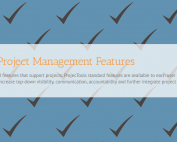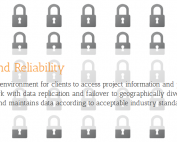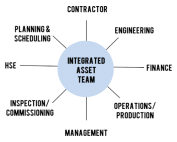AEC Software Guide
We’re going to address the question, “Are your buyers looking at AEC (Architecture, Engineering, Construction) software making the ten critical demands that software buyers should be making?”
Software market is usually driven by legitimate, pressing business problems that need to be solved, things like schedule slippage, cost growth, preventable stoppages in production. These pressing problems may seem huge and so pressing that it might tempt you to settle for applications that look good and just don’t deliver. You want to be the hero. In order to be the hero you got to make the ten critical demands that every software buyer should be making when shopping the Architecture, Engineering Construction and Project Portfolio Management software space.
Let’s just take a look at what happens when the critical demands aren’t made during an AEC software purchase. You end up with unhappy users because you purchase software that doesn’t eventually work. That’s a huge bummer for the folks who use it. When they communicate that back to you or around the company and so forth, that’s going to make an unhappy you.
Another thing that happens when you don’t make the critical demands is that there’s low adoption or no adoption of your software purchase. Buying an application that users don’t need or don’t know how to use is a waste of money. If they don’t use it, you’re totally missing the boat, and it was a pointless AEC Software purchase.
Another thing that happens when you don’t make the critical demands is the cost escalates or inflates and it ends up blowing your budget. That makes you look bad, puts you on the defense and it attracts scrutiny from executives, management, also maybe clients. You don’t know who a bad AEC software purchase is going to upset. You want to avoid that altogether by making the right demands when you’re shopping for software.
Another one is implementation delays. Your team isn’t sold on the value of the AEC application that you’re buying. They’re not going to make a lot of time to help with the implementation. Another thing you want to demand is that your software provider cares about your success because if they don’t care about your success your schedule’s on the back burner. You got to make a demand that they play your game on your timeline. We have this guy over here in the corner and he’s saying, “Thousands of dollars, countless hours to implement and train, and I’m still running spread sheets in parallel.” That is a very common frustration with the folks that buy AEC software to use themselves. It is also very common for folks that have AEC software purchased for them, is that the applications either don’t work or they take so long to truly, fully implement that they have to use two systems at one time. That’s terribly frustrating. It’s a huge waste of time, effort, resources and the moral portion of it, like having to use a spreadsheet and, for instance, a document management assistant to manage progress and status. That’s just demoralizing.
I’m going to give you guys the ten critical demands to make from AEC software companies and yourselves and your teams that will ensure that your AEC software purchase is a good one and that your implementation is successful.
The first demand that you need to make is demanding that person buying your AEC software whether it’s you or somebody else in your company is that they focus on value rather than price. At the end of the day who cares how cheap it is if it doesn’t work? You only deal with price once. You have to deal with poor quality AEC software or poor quality service every single day. Next, take a look at what’s most important, is what your business can gain from using AEC software tools. Rather than gaining a tool just to say you have a tool. That’s really not the right way to go. Focus on value that it’s going to add, business problems that you’re going to solve rather than price. You’ll be on your way to making the right demands from your AEC software buyers.
The second thing you got to do is demand due diligence. Buying a new piece of critical AEC software is a big deal. It changes the way you do business. Properly vetting your software partner is key, just as you properly vet any employee or any key employee or any key supplier or partner, etc. In this vetting process you need to demand that your software provider proves that they have financial viability, that they’re going to be around in ten years, and that they have innovative ability, that they’re going to be ahead of the competition, and really give you the tools that you need to execute your AEC flawlessly every time from design and engineering through construction and handover. You want to make sure they have integrity. There’s nothing worse than doing a software deal and then finding out that they’re a bunch of grease balls. Luckily this doesn’t happen very often. We live in a very social age, so when you do encounter greasy people or greasy people are out there word gets around. Vetting people is great and definitely something you should demand your AEC software buyers do.
The third thing to do is demand transparency. Demand that there are no hidden costs in your AEC software purchase. You need to demand that your teams read the service agreement. Demand from yourself that you read the service agreement. Demand that you call the references and don’t be afraid to ask about cost, and unexpected cost, and how they felt about any cost escalations. What was the cause of those and what happened? How did the software company handle it? The third thing is ask your sales person. It’s their job to give you an accurate quote and make you aware of all the possible costs. Demand that they give you an accurate quote and demand that they give you something they can stand by not just for this year but for next year and the year after, too.
The fourth thing is to demand a roadmap or a growth plan. If an AEC application works like you need it to you’ll be solving real problems and creating real value for your company. Chances are you’re going to want to roll it out to more divisions or Engineering and construction projects company-wide, perhaps. To avoid unexpected jumps in price, you want to make sure to get pricing for your plausible growth scenarios from years two through five, at least. Definitely understand the size of your company and have your rep give you scenarios. Demand that they’ll stand by them.
The fifth thing is demand that your AEC software buyers or yourself look past cool technology and features. This isn’t really intuitive, but solving business problems is way more important than any one feature, platform or benefit. You don’t want this to be you. Always have problems and objectives in mind as your searching for AEC software. Don’t get distracted by bells, whistles and unproven technology. This seems like a simple concept, but we hear this mistake time and time again. If you’re buying an AEC application based on promises of what could be, you’re really setting yourself up to fail. Make sure it’s something that’s proven in your industry. If you’re buying the idea of an application you’re also setting yourself up to fail. If you can’t see the software demonstrating core AEC tasks before you buy it, it’s probably a bad move. Demand that the AEC software you’re buying is more than an idea, and that it’s more than a promise, and that they show you how to solve your business problems.
The sixth thing is demand success on day one. A blank slate can sound really nice, but not in the context of business critical software. Extensive customization and configuration is very expensive and it’s time consuming, and slow to be delivered. If an application does have the key functionality, go with it. The customization and configuration route, at the end of the day, is going to spell huge expense, slow delivery, and anguish and a lot of uncertainty. You have your expectations versus the spec versus the end product. There are all kinds of cartoons depict this but I settled with this guy. He’s unique, man. Don’t play the customization game and demand that whoever is in charge of buying your software doesn’t make that gamble with business critical AEC software or any software for that matter.
The seventh thing is demand industry experience. There are generic AEC software offerings out on the market. They might be cheaper, they might be prettier, they might be more flexible, but they’re also oftentimes unproven in your industry, difficult to configure, and then time consuming to configure and get working just who you need it. When you demand an industry specific or vertical centric piece of software, or experience that supports that, it might be more expensive. It’s going to be specialized to what you need. The people that work at that software company are going to be able to act as consultants to give you the true best practices. This is a huge value that is often overlooked. It is tragic that it is, but unfortunately so. If the AEC software company has walked down the same road before they’re going know how to navigate the turns and the bumps in the road. You’ll have smoother implementations, quicker implementations and they’re going to speak your language – the language of the AEC industry.
The eighth thing is demand the ability to integrate. The inability or unwillingness to integrate AEC applications is really bad. You need to demand this from your AEC software provider. It’s not 1998. Your applications do need to work together. If they don’t work together today, that might be okay. The possibility of that happening, of that integration, needs to be planned for down the road. You also need to ask about the integrations from your sales rep and to get a good track record and get references and get quotes for these integrations. You don’t want an integration where they say, “Oh yeah, that’s easy. We can do that later,” to actually be a huge deal that takes forever and is a lot of effort and costs a ton of money. Demand that they commit to a timeline, a scope and a price before you settle on an AEC software provider. It’s ok to get your IT group involved in this conversation to vet the software company’s claims.
The ninth thing is demanding realistic training and implementation plans. Can your team leverage new AEC tools without adequate training? Probably not. Is the software partner willing and able to thoroughly map out and deliver meaningful AEC-focused training and implementation that’s going to make your power users and your casual users successful? Do they offer the trainer approach so your on-staff experts can bring your other team members up to speed? These are all things to think about. Since training is key, you need to demand effective training from your software partner, and demand realistic training and implementation plans. If they’re wishy-washy about on-site versus remote and on-site implementation’s important to you, which it should be because they’re more successful, demand that they’re going to be there because you want your team to be trained and ready to go in your application.
Last critical demand we need to think about here is demanding a culture from your company and your software company that embraces change. Understand that change is hard for some people. Not everybody on the team wants new applications and efficiency, visibility, and accountability. If you can communicate effectively about a new application and really articulate what you’re going to get out of it in terms of efficiency, visibility and accountability, those are really hard things for people to argue against. That is a way that you can demand that your company embraces the change that’s coming to them with new AEC software. Nothing rallies your team around a new application like strong executive support. Make sure your executive team is there behind you demanding that your culture shifts along with your new tools to bring increased efficiency, visibility and accountability and you’ll have an easier time with it.
Thanks for joining us today. If you ever want to talk software, if you’re buying any kind of software and you want to chat about it and what to look for or run it by us, whether it’s software that competes with us or doesn’t compete with us, we are always open to having a conversation about software. Just drop us a line at info@projectools.com.
ProjecTools Product Information
ProjecTools Client Spotlight
ProjecTools Client Spotlight "I don't see how companies can manage projects like [...]
Standard Project Management Features
ProjecTools subscriptions provide valuable standard features that support projects. ProjecTools standard features are available to each user to complement core application functions and business processes. Utilize the modules below to increase top-down visibility, communication, accountability
Security and Reliability
Users need a secure, reliable environment to access project information and perform work. All applications and client data resides in a private cloud network with data replication and failover to geographically diverse datacenter equipment. ProjecTools provides 99.5% Network Availability
Construction Project Management Services
ProjecTeams is proven for flexible on-site or remote project deployments. Each ProjecTeam specialist has deep work history with a career of improving project execution, information management processes, with tools that make projects efficient, timely, and profitable.
ProjecTools Resources
Spreadsheets and Email as Project Management Tools
Projects have too many moving parts and too many players to be trusting critical data to spreadsheets and emails. You need a spreadsheet reduction strategy.
Project Management Assessment
Project Management Assessment Assess your project management practices against the best project execution teams in the Capital Construction, [...]
Document Management Software ROI
Document management is massively important for engineering and construction projects. Take the approach and use the tools that add the most value.
Aligning Document Control and Cost Control
Align Document Control with Cost Control and create seamless progress and earned value reports to stay on budget and improve cash flows.
ProjecTools Videos, Demos, and Webinars
Optimizing Review and Approval Processes for Engineering
Let’s talk about review and approvals, and closed-loop systems, and how to execute the review and approval processes for engineering and commercial...
The Keys to Successful Document Management
Let's talk specifically about document management software, and the key factors for clean and organized documentation, accessibility, finding a system...
Document Management Software ROI
Document management is massively important for engineering and construction projects. Take the approach and use the tools that add the most value.
Document Distribution and Access for EPC and Construction
Global projects have global teams that need to be in the loop. Cloud technology takes the pain out of giving teams on demand access to project data.






